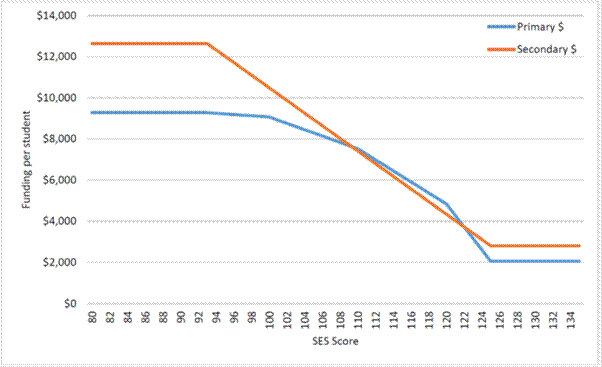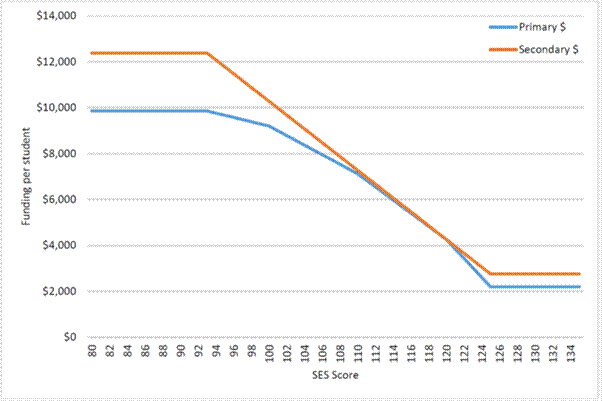Background
2.1
Amendments proposed by the bill which will commence on 1 January 2018,
and deliver a robust, needs-based school funding system. In doing so they will
remove a patchwork of 27 unfair 'special' arrangements made by the former Labor
government. These deals, which see similar students in similar schools treated
differently simply because of the state in which they live, have resulted in a
shambolic, inconsistent system in dire need of reform.
2.2
Dr Ken Boston, who was a panellist on the Review of Funding for Schooling,
outlined the 'corruption' of the original Gonski report:
In the run-up to the 2013 election, prime minister Kevin Rudd
and education minister Bill Shorten hawked this corruption of the Gonski report
around the country, doing deals with premiers, bishops and the various
education lobbies. These bilateral negotiations were not a public and open
process, as would have been achieved by the National Schools Resourcing Body;
they dragged on for twenty-one months up to the September 2013 election; and
they led to a thoroughly unsatisfactory situation: agreements with some states
and not with others, and – among participating states – different agreements
and indexation arrangements.[1]
2.3
The government is determined to address this unfairness and these
distortions, and enshrine a fair, needs-based and transparent system of funding
for all Australian school students.
Changes proposed by the bill
2.4
Funding entitlements are currently calculated on the basis of previous
funding levels, rather than on the basis of need as measured by the Schooling
Resource Standard (SRS).[2]
The SRS refers to a base per-student amount as well as loadings for school
location, size, low socio-economic status (SES) students, and other factors.[3]
The SRS funding amount for a primary student in 2014 was set at $9271, to be
indexed at a rate of 3.6 per cent annually.[4]
The SRS funding amount for a secondary student was set at $12 193 in 2014, to
be indexed in the same manner.[5]
The 2018 base SRS amounts will be amended by the bill to: $10 953 for primary
students; and $13 764 for secondary students.[6]
Future indexing arrangements are described in Chapter 3.
2.5
Under these arrangements, it is estimated that it would take another 150
years for all schools to transition to the SRS. To ensure that students with
the same need in the same sector receive the same level of government support,
the bill proposes a number of changes to how financial assistance is calculated
under the Act.[7]
Part 1—new funding arrangements
2.6
The bill is divided into three parts. If enacted, the first part would
introduce a number of changes relating to the new funding mechanisms,
including:
-
Incorporating the SRS into the funding model, as recommended by
the 2011 Review of Funding for Schooling. The SRS would still comprise a
base, per student amount, and in the case of non-government schools, would be
discounted by any given school's capacity to contribute. The base amount would
also be supplemented by loadings for disadvantage such as indigeneity,
remoteness and disability.
-
Transitioning to a funding approach which would see the
Commonwealth providing a consistent share of the SRS, this share being:
-
20 per cent for state schools; and
-
80 per cent for non-government schools.[8]
2.7
Provisions within Part 1 of the bill would also establish a starting
Commonwealth share percentage for all schools, with the aim that all schools
transition to their relevant share of the SRS by 2027. The starting
Commonwealth share percentage would be adjusted each year from 2018 to ensure
full transition by 2027. Where necessary, schools would be provided with
transition adjustment funding during the 10-year transition period.[9]
2.8
Part 1 of the bill would see indexation of base funding rates tied to an
indexation rate which would ensure that growth in funding keeps up with wages
and cost growth in the wider economy, but would not drop below three per cent.[10]
2.9
How the 'student with disability' loading is calculated would be changed
to include differentiated loadings which better reflect student needs in the
classroom.[11]
2.10
The Nationally Consistent Collection of Data on School Students with
Disability (NCCD) now provides numbers of students that require different
levels of assistance to support their access and participation in learning.
2.11
From 2018, there will be a differentiated loading for the top three NCCD
levels (supplementary, substantial and extensive) with loadings ranging from 33
to 312 per cent depending on need.[12]
2.12
Part 1 of the bill would also require the Minister to determine, in
writing, non‑government schools' individual socio-economic status (SES)
score, reflecting the particular circumstances of each school in terms of its
capacity to contribute. The bill would remove the existing power of the
Minister to determine a single SES score for a group of schools by legislative
instrument, which produced 'system weighted' SES scores for certain
non-government schools.[13]
2.13
In effect, Part 1 of the bill would reduce the benefit afforded to non‑government
primary schools by more fairly calculating schools' capacity to contribute.[14]
2.14
This change comes about due to revisions to the capacity to contribute
proportions contained in subsection 54(3) of the Act. The current inequitable
arrangements mean that non-government primary schools within the 108 to 122 SES
band receive more funding that their counterparts in the secondary sector. This
is despite the fact that 'the cost of delivering education in is much higher in
secondary.'[15]
2.15
Figure 2.1 demonstrates the bulge in the non-government primary school
capacity to contribute curve, where primary students attract more government
funding than secondary students. This is another example of the special deals
made by the former government
Figure 2.1—Non-government
schools capacity to contribute settings (based on 2018 SRS).[16]

2.16
The committee heard that the former government did not consult with the
independent sector before this anomaly was introduced.[17]
2.17
Figure 2.2 below illustrates the revised capacity to contribute curves.
Under the new arrangements non-government primary schools in the 108–122 SES
band would no longer receive more government funding than their secondary
counterparts. These arrangements were supported by representatives of the non-government
sector.[18]
Figure 2.2—Proposed
capacity to contribute settings (based on re-based 2018 SRS)[19]

Part 2—conditions of financial assistance
2.18
Part 2 of the bill would see the Preamble and Objects of the Act updated
and aligned with the principles of needs-based, transparent, sustainable
funding, nationally-agreed evidence‑based reforms and goals. Part 2 would
also stipulate the following conditions of financial assistance to states and
territories:
-
that they implement national policy initiatives for school
education as agreed by the Education Council of the Council of Australian
Governments (Ministerial Council) or otherwise prescribed by the regulations;
-
that they are party to a national agreement on school education
(to be developed collaboratively through the Council of Australian
Governments);
-
that they are party to a bilateral agreement with the
Commonwealth relating to implementation of school education reform for both
state and non‑government schools within their jurisdiction; and
-
that they fulfil their obligations under the national and
bilateral agreements.[20]
2.19
The setting of state and territory own funding contributions would be
left to the states and territories. However, to prevent cost-shifting to the
Commonwealth, states and territories would be required to, at the very least,
maintain their share of 2017 per-student funding levels as a condition of
Commonwealth funding.[21]
2.20
Part 2 of the bill would see the following new ongoing policy
requirements for approved authorities stipulated for non-government schools:
-
that they co-operate with their respective states and territories
in implementing national policy reforms and agreements discussed above; and
-
that they implement policy initiatives in accordance with the
regulations.[22]
2.21
Part 2 would also see the outdated distinction between participating and
non‑participating schools removed, helping to align the system with the
government's policy of funding states under consistent, needs-based
arrangements.[23]
2.22
In addition, the requirement for approved authorities which are
responsible for more than one school to have implementation plans would be
removed, enabling the government and state and territory jurisdictions to work
cooperatively in implementing and monitoring national policy agreements.
Approved authorities would also have the requirement to have school improvement
frameworks in place removed, allowing them to manage improvement processes at
the local level, thereby reducing red tape.[24]
2.23
Finally, transparency in funding for Commonwealth schools would be increased
through inclusion of additional annual reporting requirements.[25]
Part 3—simplify the calculating funding entitlements
2.24
Part 3 of the bill seeks to refocus the consultation process for
significant regulations which impact state and territory governments. If
enacted, the changes would require the Minister to consult with the Ministerial
Council in making regulations which affect ongoing policy, funding requirements
of approved authorities for state schools, or conditions imposed on states and
territories for funding received under the Act.[26]
2.25
The changes proposed would also simplify the Act for the purposes of
calculating funding entitlements. Other changes would include:
-
enabling some obligations of approved authorities, block grant
authorities and non-government representative bodies to acquit Commonwealth
schools funding;
-
amending provisions regarding decisions to vary and revoke
funding approvals in order to a) enable the imposition of conditions intended
to bring approval holders into compliance with the Act, and b) streamline the
process for review of decisions by removing the internal review step.[27]
2.26
The third part of the bill would also amend provisions relating to
reducing funding to, or recovering funding from, approval holders for non-compliance
or overpayment, in order for the Minister to be satisfied of the circumstances
giving rise to non-compliance or overpayment.
2.27
Finally, Part 3 would enable broader delegation of administrative
functions by the Secretary of the Department of Education and Training.
2.28
The next chapter looks at key aspects of the bill.
Navigation: Previous Page | Contents | Next Page